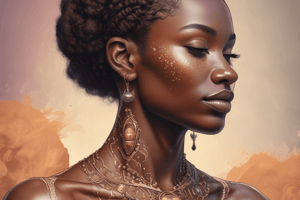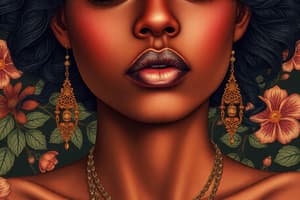Podcast
Questions and Answers
What are the three pigments that determine skin color?
What are the three pigments that determine skin color?
- Hemoglobin (correct)
- Melanin (correct)
- Carotene (correct)
- Cholesterol
Carotene can give the skin an orange-yellow cast.
Carotene can give the skin an orange-yellow cast.
True (A)
What causes cyanosis?
What causes cyanosis?
Poorly oxygenated hemoglobin.
A yellow cast to the skin, known as ______, indicates a liver disorder.
A yellow cast to the skin, known as ______, indicates a liver disorder.
What type of glands are sebaceous glands?
What type of glands are sebaceous glands?
Match the following skin pigments with their descriptions:
Match the following skin pigments with their descriptions:
What is the role of eccrine sweat glands?
What is the role of eccrine sweat glands?
Apocrine sweat glands are primarily responsible for body temperature regulation.
Apocrine sweat glands are primarily responsible for body temperature regulation.
What is the primary pigment responsible for hair color?
What is the primary pigment responsible for hair color?
The central core of a hair follicle is known as the ______.
The central core of a hair follicle is known as the ______.
Flashcards are hidden until you start studying
Study Notes
Skin Color and Pigmentation
- Melanin contributes to skin color; variations include yellow, reddish-brown, and black hues.
- Produced by melanocytes, melanin levels increase with sunlight exposure, protecting DNA from UV damage.
- Higher melanin content results in darker skin tones, while lower levels lead to lighter skin.
- Carotene, an orange-yellow pigment found in vegetables, can influence skin color, particularly when consumed in large quantities (e.g., carrots).
- Hemoglobin, present in dermal capillaries, imparts a red hue to the skin, influenced by oxygen levels.
Cyanosis
- Cyanosis occurs when hemoglobin is poorly oxygenated, leading to a bluish tint in the skin, particularly noticeable in lips, fingers, and toes.
Other Skin Color Changes
- Erythema (redness) can result from embarrassment, inflammation, hypertension, fever, or allergies.
- Pallor (blanching) may be caused by emotional stress, anemia, low blood pressure, or impaired blood flow.
- Jaundice results in a yellow skin tone due to liver disorders and excess biopigments.
- Bruising (black and blue marks) occurs when blood escapes circulation, potentially indicating conditions like hemophilia or Vitamin D deficiency.
Appendages of the Skin
- Skin appendages, arising from the epidermis, play crucial roles in body homeostasis, including exocrine glands.
Cutaneous Glands
-
Sebaceous (oil) glands:
- Function as holocrine glands, releasing sebum after cells undergo autophagy.
- Present across the skin, except on palms and soles, providing moisture, softness, and bacterial protection.
- Can lead to acne when ducts are blocked; blackheads form from dried, oxidized material, while whiteheads remain undried.
-
Sweat (sudoriferous) glands:
-
Two types: apocrine and eccrine.
-
Apocrine:
- Located in armpits and genital areas; produce thick, odorous fluids that begin functioning at puberty.
- Larger in size compared to eccrine and have minimal impact on temperature regulation.
-
Eccrine:
- Open onto skin's surface via sweat pores, producing acidic sweat that inhibits bacterial growth.
- Regulates body temperature through perspiration and contains water, salt, and traces of metabolic waste.
-
Hair Anatomy
- Hair structure consists of a root enclosed in a follicle and a shaft that projects above the skin.
- Made from hard keratinized epithelial cells with growth occurring in the hair bulb's matrix.
- Melanocytes in the follicle provide pigment for hair color, dependent on the differentiation of nearby cells.
- Hair's density, size, and orientation vary by ethnicity, affecting growth patterns.
Hair Structure
- Central medulla: core made of large cells and air spaces.
- Cortex: thick outer layer of flattened cells surrounding the medulla.
- Cuticle: the outermost layer of overlapping cells, the most heavily keratinized, protecting inner structures and prone to damage at the hair tips.
Studying That Suits You
Use AI to generate personalized quizzes and flashcards to suit your learning preferences.




